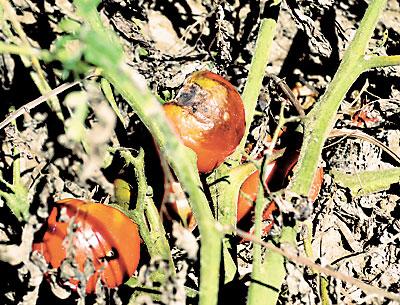A Bad Year For Tomatoes

Home tomato growers and farmers across the East End have been bemoaning the disease called late blight, which “pretty much wiped out most of the tomato crops, very quickly,” said Pam Greene, vice president of the Peconic Land Trust, on Monday.
“The weather was perfect for carrying it through the fields,” she said, and likewise to backyard gardens. The trust alerted its members to the problem early so they could take precautionary measures.
The yearly Great Tomato Taste-Off, which was to be held over Labor Day at the trust’s Quail Hill community farm in Amagansett, was canceled for the second year in a row after 50 varieties were severely compromised.
Scott Chaskey, the Quail Hill farmer, said there was no easy solution to what he called a “powerful problem.” He saw the blight in the fields in late July, although it was reported on the North Fork as early as May.
That was shockingly early, Mr. Chaskey said. The pathogen usually arrives later, as its name indicates. “We immediately pulled 50 or 60 plants,” he said. Late blight also kills potatoes; luckily, he said, it has never affected Quail Hill’s.
In 2009 the disease, which is thought to have begun with infected plants from Georgia that were sold in big-box stores, devastated tomato plants throughout the Northeast, said the farmer, and he was forced to pull 8,000 plants when it first appeared at Quail Hill. “Spores can travel 30 miles,” he said. “You have to remove and smother the plants right away,” said Ms. Greene.”
Before that cold and rainy year, said Mr. Chaskey, late blight was not common, but this year is the third out of four that it has affected the farm. He advised home gardeners to buy their seedlings locally, where they know what they are getting.
The signs of the disease are “pretty obvious,” said Mr. Chaskey on Monday, as he pointed out affected leaves and fruit in a Quail Hill tomato patch. “The fruit can’t ripen. Instead, it turns black and rots on the vine.” The pathogen also shows up on the backs of leaves as a black spot that is sometimes surrounded by a white mold.
Four hundred pounds of San Marzano plum tomatoes, a variety much prized by professional chefs that is used for making sauce, survived and have been harvested.
Meg McGrath, an associate professor at the Cooperative Extension, said the blight has been seen as far west as Brentwood. Beginning in 2009, she said, “one small start wound up hitting all of Long Island.”
As for a remedy, Ms. McGrath said conventional farmers use fungicides, but “it is a hard disease to control.” Both conventional and organic farmers ground-spray to start with, but once late blight is confirmed they try stronger, more targeted treatments. “It gets expensive,” she said.
Quail Hill plants its tomatoes in many different places and rotates its crops, which worked well for a while, said Mr. Chaskey. He sprays copper, an organic substance, both as a preventive and a treatment. Late blight is a strong pathogen, he said. “It’s what caused the Irish potato famine.” He would like to see more research into alternative methods.
Marilee Foster, a Sagaponack farmer, uses fungicides and ties up tomato plants so the leaves don’t touch the ground. Since late blight loves moisture, she said, she tries to give the plants “as much sun as possible.” Last year she tried copper, which attacks the blight topically, but she wasn’t pleased with the results. She knew it would be worse this year because of the mild winter, she said, explaining that low temperatures kill spores.
“I lost minimally,” said Ms. Foster, “because I reduced the variety of tomatoes I grow.” It was actually a stellar tomato year, she said — a good yield of mostly heirlooms.
Molly Channing, who grows 60 varieties of tomatoes on land adjacent to the Channing Daughters Winery in Bridgehampton, thinks she may be “the only one out here that doesn’t have it . . . I am grateful, extremely lucky.” She specializes in organic heirlooms, the most fragile of all. The last few years she was not so lucky.
“We sprayed copper on the tomatoes when we heard, a long time ago,” Ms. Channing reported. “We didn’t want to use anything toxic. My customers expect organic heirlooms, so it was that or lose the crop.
